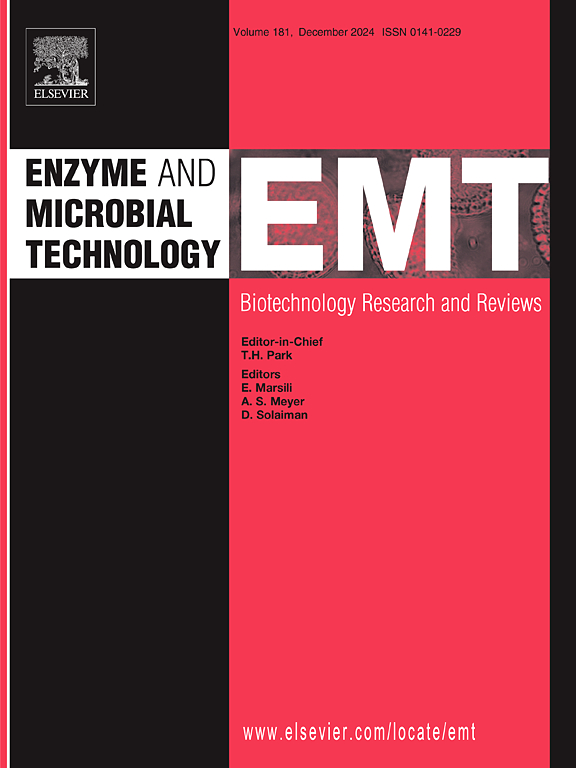Functional characterization of a Stevia rebaudiana flavonoid glycosyltransferase
IF 3.7
3区 生物学
Q2 BIOTECHNOLOGY & APPLIED MICROBIOLOGY
引用次数: 0
Abstract
Stevia rebaudiana, a perennial herb, is recognized not only for its sweet steviol glycosides but also for its rich flavonoid content, which confer pharmacological properties including anti-inflammatory, antimicrobial, and anticancer activities. However, the enzymatic basis underlying flavonoid modification in S. rebaudiana remains poorly understood. In this study, we identified, cloned, and heterologously expressed a novel flavonoid glycosyltransferase gene, SrUGT72B1 in E. coli. The recombinant SrUGT72B1 catalyzed the glycosylation of multiple flavonoids using UDP-glucose as the primary sugar donor, and exhibited broad substrate promiscuity toward apigenin, luteolin, phloretin and kaempferol. In addition to UDP-glucose, SrUGT72B1 also accepted UDP-xylose and UDP-rhamnose, with UDP-glucose exhibiting the highest catalytic efficiency. Biochemical characterization revealed that the enzyme functions optimally at pH 9.0 and 50 °C. Notably, SrUGT72B1 demonstrates regioselective 5-O-glycosylation toward apigenin, a rare activity among plant glycosyltransferases. Molecular docking and molecular dynamics simulations provided structural insights into this unique regioselectivity and substrate recognition. Together, these findings establish SrUGT72B1 as a previously uncharacterized flavonoid 5-O-glycosyltransferase, expanding the functional landscape of plant UGTs and offering potential applications in the biosynthesis of value-added flavonoid glycosides.
甜菊糖苷类黄酮糖基转移酶的功能表征
甜菊菊是一种多年生草本植物,不仅因其甜菊醇糖苷,而且因其丰富的类黄酮含量而被公认,其药理特性包括抗炎、抗菌和抗癌活性。然而,黄酮类化合物修饰的酶基础尚不清楚。在这项研究中,我们在大肠杆菌中鉴定、克隆并异种表达了一种新的类黄酮糖基转移酶基因SrUGT72B1。重组蛋白SrUGT72B1以udp -葡萄糖为主要糖供体催化多种黄酮类化合物的糖基化,对芹菜素、木犀草素、根皮素和山奈酚表现出广泛的底物混交性。除了udp -葡萄糖外,SrUGT72B1还接受udp -木糖和udp -鼠李糖,其中udp -葡萄糖的催化效率最高。生化表征表明,该酶在pH 9.0和50 °C条件下功能最佳。值得注意的是,SrUGT72B1表现出对芹菜素的区域选择性5- o糖基化,这是植物糖基转移酶中罕见的活性。分子对接和分子动力学模拟为这种独特的区域选择性和底物识别提供了结构见解。总之,这些发现确定了SrUGT72B1是一种以前未被发现的类黄酮5- o糖基转移酶,扩大了植物ugt的功能景观,并在增值类黄酮苷的生物合成中提供了潜在的应用。
本文章由计算机程序翻译,如有差异,请以英文原文为准。
求助全文
约1分钟内获得全文
求助全文
来源期刊

Enzyme and Microbial Technology
生物-生物工程与应用微生物
CiteScore
7.60
自引率
5.90%
发文量
142
审稿时长
38 days
期刊介绍:
Enzyme and Microbial Technology is an international, peer-reviewed journal publishing original research and reviews, of biotechnological significance and novelty, on basic and applied aspects of the science and technology of processes involving the use of enzymes, micro-organisms, animal cells and plant cells.
We especially encourage submissions on:
Biocatalysis and the use of Directed Evolution in Synthetic Biology and Biotechnology
Biotechnological Production of New Bioactive Molecules, Biomaterials, Biopharmaceuticals, and Biofuels
New Imaging Techniques and Biosensors, especially as applicable to Healthcare and Systems Biology
New Biotechnological Approaches in Genomics, Proteomics and Metabolomics
Metabolic Engineering, Biomolecular Engineering and Nanobiotechnology
Manuscripts which report isolation, purification, immobilization or utilization of organisms or enzymes which are already well-described in the literature are not suitable for publication in EMT, unless their primary purpose is to report significant new findings or approaches which are of broad biotechnological importance. Similarly, manuscripts which report optimization studies on well-established processes are inappropriate. EMT does not accept papers dealing with mathematical modeling unless they report significant, new experimental data.
 求助内容:
求助内容: 应助结果提醒方式:
应助结果提醒方式:


